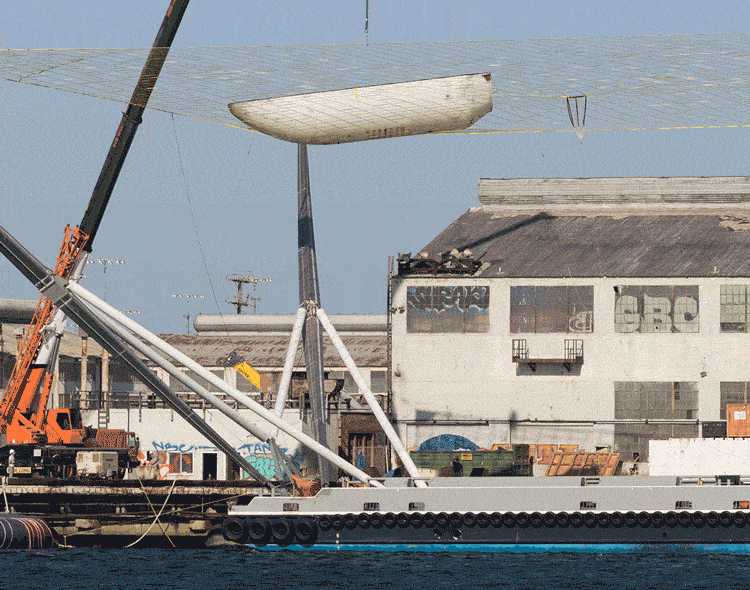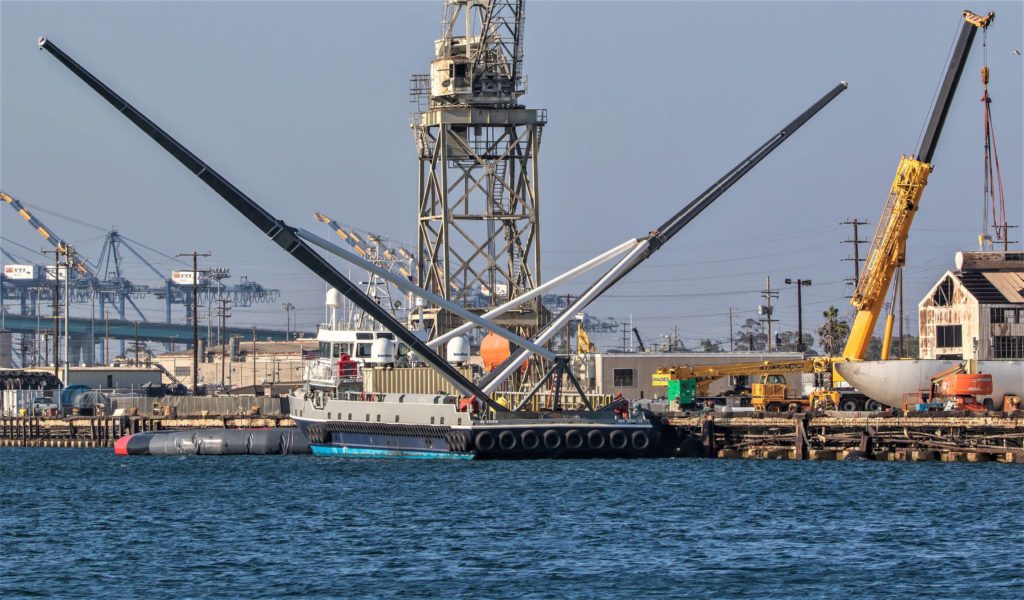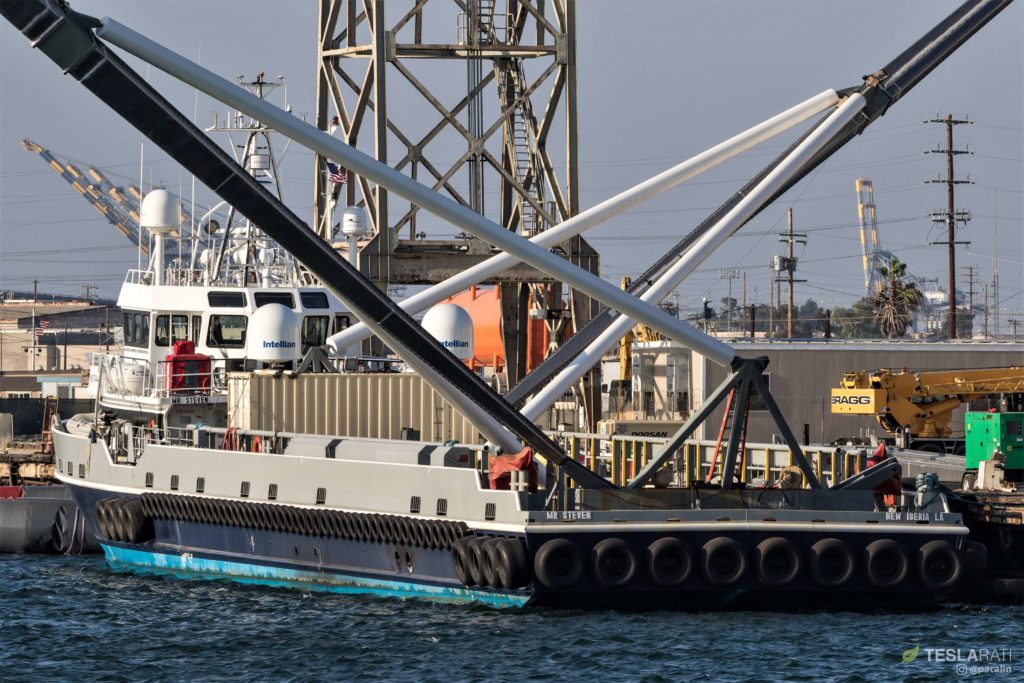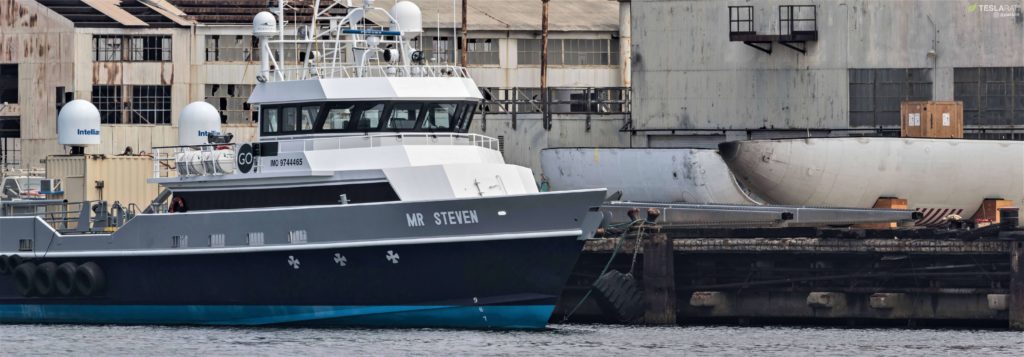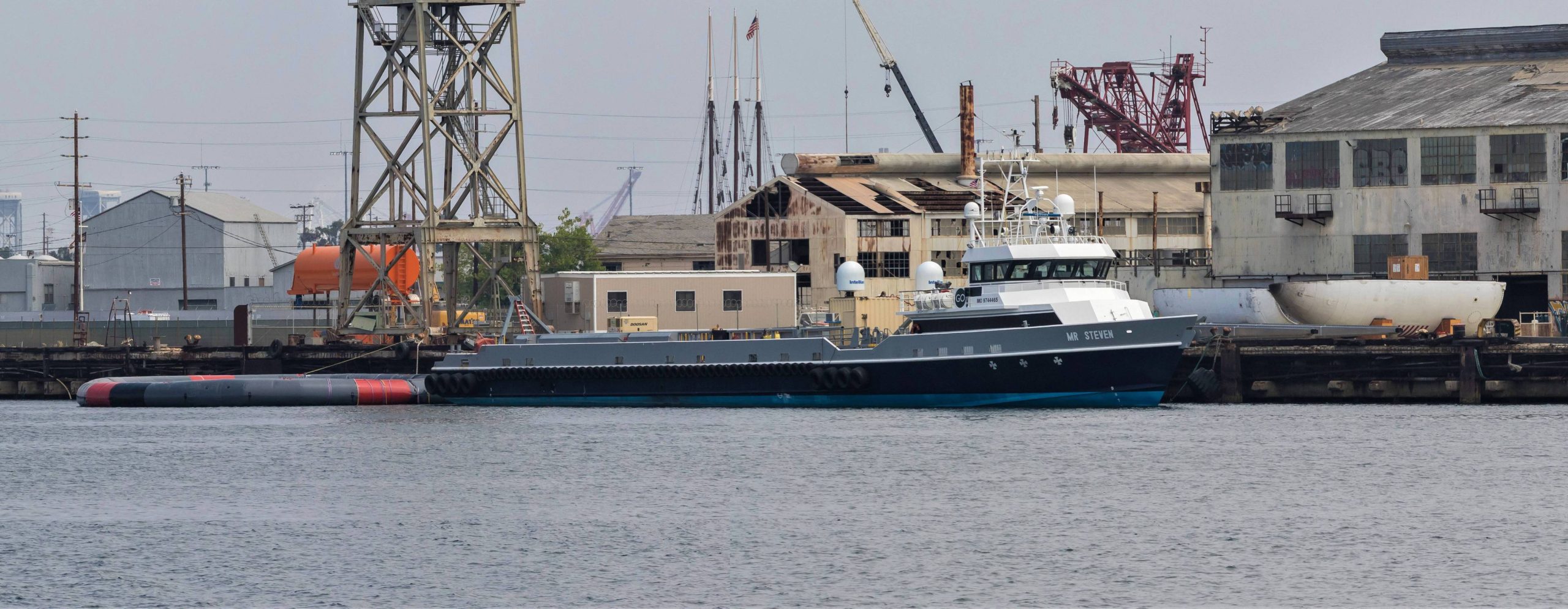
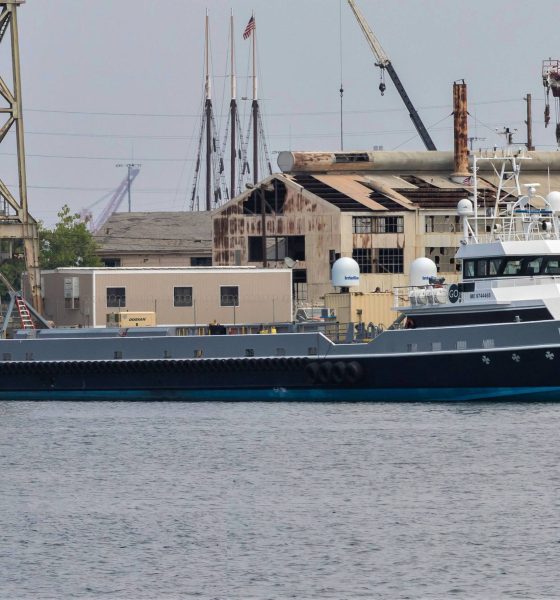
News
SpaceX fairing catcher Mr Steven armless once more for maintenance and upgrades
SpaceX’s Falcon 9 fairing catcher ship Mr Steven has had all four new arms removed as the company’s recovery engineers and technicians continue to iterate on his fairing recovery mechanism and operational strategy.
The purpose of this round of arm removal is unknown, but the work going on at Berth 240 is nevertheless a fascinating glimpse into SpaceX’s preferred mode of operations, mainly focusing on constant improvement, tireless iteration, and minimized bureaucratic burden.
Two of Mr Steven’s arms were laying dockside yesterday. Perhaps adjustments due to last week’s fairing drop tests? Getting close to next fairing recovery attempt mid-September. #SpaceX #mrsteven @Teslarati pic.twitter.com/Ev3r2N2bBv
— Pauline Acalin (@w00ki33) August 19, 2018
Originally spotted testing the behavior of a Falcon 9 fairing half in Mr Steven’s new net around August 13th, West Coast recovery technicians had completely removed all four of the vessel’s large arms and all eight of his arm booms just one week later, leaving the boat armless for the first time in roughly two months.
The speed of that seemingly significant hardware removal alone is rather interesting, suggesting that routine removal of Mr Steven’s arms could be wholeheartedly feasible for short-term requirements, be it a clearance issue for traversing canals or perhaps even some sort of modular recovery setup that could optimize Mr Steven for catching Falcon fairings, Dragons, and perhaps even Falcon upper stages.
- A gif demonstrates just how taut Mr Steven’s net can be, thanks to mechanized rigging. 08/13/18 (Pauline Acalin)
- Mr Steven sans two arms, August 19th. Note the red and black inflatable structure floating at his bow. (Pauline Acalin)
- Just two arms and a dream. (Pauline Acalin)
- Mr Steven sans arms once more, August 21st. (Pauline Acalin)
Wild speculation aside, it can be said with certainty that the ability to remove Mr Steven’s arms so rapidly will make the lives and work of the technicians and engineers tasked with maintaining, testing, and improving the vessel’s recovery mechanisms considerably easier, demanding just a few days of work for complete disassembly. SpaceX CEO Elon Musk did note around the time of the upgraded arm and net installation that those new arms would be retractable and “springy, like a highly damped trampoline.”
The inclusion of large white damping booms to support that supposed springiness was indeed visually confirmed while SpaceX was testing the vessel’s net with a real Falcon 9 fairing, but it’s quite clear that no retraction mechanism was included on the first iteration of Mr Steven’s upgraded arms. Chances are good that this full-up arm removal is related in some way to Musk’s retraction reference, perhaps triggered by observations made during that aforementioned testing with a real fairing half, just days after which arm removal had already been half-completed.
Yes, and springy, like a highly damped trampoline
— Elon Musk (@elonmusk) July 11, 2018
Mr Steven’s next shot at catching a Falcon 9 fairing will follow the launch of Argentinian Earth-sensing satellite SAOCOM-1A, to be followed up soon after with the SpaceX launch of SAOCOM-1B. 1A is currently targeting late September or early October for its journey to orbit.
Meanwhile, the lightweight payload (~1600 kg/~3500 lb) and relatively low orbit (near-polar, 620 km/385 mi) have aligned to allow the Falcon 9 Block 5 booster the chance to be the first SpaceX rocket to debut the company’s West Coast rocket landing zone, companion to the pad’s two well-worn East Coast brethren.
For prompt updates, on-the-ground perspectives, and unique glimpses of SpaceX’s rocket recovery fleet check out our brand new LaunchPad and LandingZone newsletters!

News
Tesla Giga Berlin draws “red line” over IG Metall union’s 35-hour week demands
Factory manager André Thierig has drawn a “red line” against reducing Giga Berlin’s workweek to 35 hours, while highlighting that Tesla has actually increased its workers’ salaries more substantially than other carmakers in the country.

Tesla Giga Berlin has found itself in a new labor dispute in Germany, where union IG Metall is pushing for adoption of a collective agreement to boost wages and implement changes, such as a 35-hour workweek.
In a comment, Giga Berlin manager André Thierig drew a “red line” against reducing Giga Berlin’s workweek to 35 hours, while highlighting that Tesla has actually increased its workers’ salaries more substantially than other carmakers in the country.
Tesla factory manager’s “red line”
Tesla Germany is expected to hold a works council election in 2026, which André Thierig considers very important. As per the Giga Berlin plant manager, Giga Berlin’s plant expansion plans might be put on hold if the election favors the union. He also spoke against some of the changes that IG Metall is seeking to implement in the factory, like a 35-hour week, as noted in an rbb24 report.
“The discussion about a 35-hour week is a red line for me. We will not cross it,” Theirig said.
“(The election) will determine whether we can continue our successful path in the future in an independent, flexible, and unbureaucratic manner. Personally, I cannot imagine that the decision-makers in the USA will continue to push ahead with the factory expansion if the election results favor IG Metall.”
Giga Berlin’s wage increase
IG Metall district manager Jan Otto told the German news agency DPA that without a collective agreement, Tesla’s wages remain significantly below levels at other German car factories. He noted the company excuses this by referencing its lowest pay grade, but added: “The two lowest pay grades are not even used in car factories.”
In response, Tesla noted that it has raised the wages of Gigafactory Berlin’s workers more than their German competitors. Thierig noted that with a collective agreement, Giga Berlin’s workers would have seen a 2% wage increase this year. But thanks to Tesla not being unionized, Gigafactory Berlin workers were able to receive a 4% increase, as noted in a CarUp report.
“There was a wage increase of 2% this year in the current collective agreement. Because we are in a different economic situation than the industry as a whole, we were able to double the wages – by 4%. Since production started, this corresponds to a wage increase of more than 25% in less than four years,” Thierig stated.
News
Tesla is seeing a lot of momentum from young Koreans in their 20s-30s: report
From January to November, young buyers purchased over 21,000 Teslas, putting it far ahead of fellow imported rivals like BMW and Mercedes-Benz.

Tesla has captured the hearts of South Korea’s 20s-30s demographic, emerging as the group’s top-selling imported car brand in 2025. From January to November, young buyers purchased over 21,000 Teslas, putting it far ahead of fellow imported rivals like BMW and Mercedes-Benz.
Industry experts cited by The Economist attributed this “Tesla frenzy” to fandom culture, where buyers prioritize the brand over traditional car attributes, similar to snapping up the latest iPhone.
Model Y dominates among young buyers
Data from the Korea Imported Automobile Association showed that Tesla sold 21,757 vehicles to the 20s-30s demographic through November, compared to BMW’s 13,666 and Mercedes-Benz’s 6,983. The Model Y led the list overwhelmingly, with variants like the standard and Long Range models topping purchases for both young men and women.
Young men bought around 16,000 Teslas, mostly Model Y (over 15,000 units), followed by Model 3. Young women followed a similar pattern, favoring Model Y (3,888 units) and Model 3 (1,083 units). The Cybertruck saw minimal sales in this group.
The Model Y’s appeal lies in its family-friendly SUV design, 400-500 km range, quick acceleration, and spacious cargo, which is ideal for commuting and leisure. The Model 3, on the other hand, serves as an accessible entry point with lower pricing, which is valuable considering the country’s EV subsidies.
The Tesla boom
Experts described Tesla’s popularity as “fandom culture,” where young buyers embrace the brand despite criticisms from skeptics. Professor Lee Ho-geun called Tesla a “typical early adopter brand,” comparing purchases to iPhones.
Professor Kim Pil-soo noted that young people view Tesla more as a gadget than a car, and they are likely drawn by marketing, subsidies, and perceived value. They also tend to overlook news of numerous recalls, which are mostly over-the-air software updates, and controversies tied to the company.
Tesla’s position as Korea’s top import for 2025 seems secured. As noted by the publication, Tesla’s December sales figures have not been reported yet, but market analysts have suggested that Tesla has all but secured the top spot among the country’s imported cars this year.
News
Tesla FSD fleet is nearing 7 billion total miles, including 2.5 billion city miles
As can be seen on Tesla’s official FSD webpage, vehicles equipped with the system have now navigated over 6.99 billion miles.

Tesla’s Full Self-Driving (Supervised) fleet is closing in on almost 7 billion total miles driven, as per data posted by the company on its official FSD webpage.
These figures hint at the massive scale of data fueling Tesla’s rapid FSD improvements, which have been quite notable as of late.
FSD mileage milestones
As can be seen on Tesla’s official FSD webpage, vehicles equipped with the system have now navigated over 6.99 billion miles. Tesla owner and avid FSD tester Whole Mars Catalog also shared a screenshot indicating that from the nearly 7 billion miles traveled by the FSD fleet, more than 2.5 billion miles were driven inside cities.
City miles are particularly valuable for complex urban scenarios like unprotected turns, pedestrian interactions, and traffic lights. This is also the difference-maker for FSD, as only complex solutions, such as Waymo’s self-driving taxis, operate similarly on inner-city streets. And even then, incidents such as the San Francisco blackouts have proven challenging for sensor-rich vehicles like Waymos.
Tesla’s data edge
Tesla has a number of advantages in the autonomous vehicle sector, one of which is the size of its fleet and the number of vehicles training FSD on real-world roads. Tesla’s nearly 7 billion FSD miles then allow the company to roll out updates that make its vehicles behave like they are being driven by experienced drivers, even if they are operating on their own.
So notable are Tesla’s improvements to FSD that NVIDIA Director of Robotics Jim Fan, after experiencing FSD v14, noted that the system is the first AI that passes what he described as a “Physical Turing Test.”
“Despite knowing exactly how robot learning works, I still find it magical watching the steering wheel turn by itself. First it feels surreal, next it becomes routine. Then, like the smartphone, taking it away actively hurts. This is how humanity gets rewired and glued to god-like technologies,” Fan wrote in a post on X.
